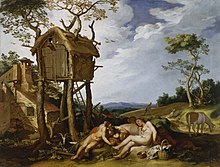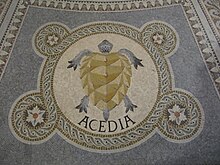The seven deadly sins, also known as the capital vices or cardinal sins, is a classification of vices (part of Christian ethics) that has been used since early Christian times to educate and instruct Christians concerning fallen humanity's tendency to sin. In the currently recognized version, the sins are usually given as wrath, greed, sloth, pride, lust, envy, and gluttony.
The Catholic Church divides sin into two categories: venial sins, in which guilt is relatively minor, and the more severe mortal sins. Theologically, a mortal or deadly sin is believed to destroy the life of grace and charity within a person and thus creates the threat of eternal damnation. "Mortal sin, by attacking the vital principle within us – that is, charity – necessitates a new initiative of God's mercy and a conversion of heart which is normally accomplished [for Catholics] within the setting of the sacrament of reconciliation."[1]
According to Catholic moral thought, the seven deadly sins are not discrete from other sins, but are instead the origin ("capital" comes from the Latin caput, head) of the others. "Deadly sins" can be either venial or mortal, depending on the situation, but "are called 'capital' because they engender other sins, other vices".
Beginning in the early 14th century, the popularity of the seven deadly sins as a theme among European artists of the time eventually helped to ingrain them in many areas of Catholic culture and Catholic consciousness in general throughout the world. One means of such ingraining was the creation of the mnemonic "SALIGIA" based on the first letters in Latin of the seven deadly sins: superbia, avaritia, luxuria, invidia, gula, ira, aced.
In the Book of Proverbs 6:16-19, among the verses traditionally associated with King Solomon, it states that the Lord specifically regards "six things the Lord hateth, and seven that are an abomination unto Him", namely:
- A proud look
- A lying tongue
- Hands that shed innocent blood
- A heart that devises wicked plots
- Feet that are swift to run into mischief
- A deceitful witness that uttereth lies
- Him that soweth discord among brethren
Another list, given this time by the Epistle to the Galatians (Galatians 5:19-21), includes more of the traditional seven sins, although the list is substantially longer: adultery, fornication, uncleanness, lasciviousness, idolatry, sorcery, hatred, variance, emulations, wrath, strife, seditions, heresies, envyings, murders, drunkenness, revellings, "and such like".Since Apostle Paul goes on to say that the persons who practice these sins "shall not inherit the Kingdom of God", they are usually listed as (possible) mortal sins rather than capital vices.
Lust
Lust or lechery (carnal "luxuria") is an intense desire. It is usually thought of as excessive sexual wants; however, the word was originally a general term for desire. Therefore lust could involve the intense desire of money, food, fame, or power as well.
In Dante's Purgatorio, the penitent walks within flames to purge himself of lustful/sexual thoughts and feelings. In Dante's Inferno, unforgiven souls of the sin of lust are blown about in restless hurricane-like winds symbolic of their own lack of self-control to their lustful passions in earthly life.
Gluttony

Derived from the Latin gluttire, meaning to gulp down or swallow, gluttony (Latin, gula) is the over-indulgence and over-consumption of anything to the point of waste.
In Christian religions, it is considered a sin because of the excessive desire for food, and its withholding from the needy.
Because of these scripts, gluttony can be interpreted as selfishness; essentially placing concern with one's own interests above the well-being or interests of others.
Medieval church leaders (e.g., Thomas Aquinas) took a more expansive view of gluttony, arguing that it could also include an obsessive anticipation of meals, and the constant eating of delicacies and excessively costly foods. Aquinas went so far as to prepare a list of six ways to commit gluttony, comprising:
- Praepropere – eating too soon
- Laute – eating too expensively
- Nimis – eating too much
- Ardenter – eating too eagerly
- Studiose – eating too daintily
- Forente – eating wildly
Greed

Greed (Latin, avaritia), also known as avarice or covetousness, is, like lust and gluttony, a sin of excess. However, greed (as seen by the church) is applied to a very excessive or rapacious desire and pursuit of material possessions. Thomas Aquinas wrote, "Greed is a sin against God, just as all mortal sins, in as much as man condemns things eternal for the sake of temporal things." In Dante's Purgatory, the penitents were bound and laid face down on the ground for having concentrated too much on earthly thoughts. Scavenging and hoarding of materials or objects, theft and robbery, especially by means of violence, trickery, or manipulation of authority are all actions that may be inspired by Greed. Such misdeeds can include simony, where one attempts to purchase or sell sacraments, including Holy Orders and, therefore, positions of authority in the Church hierarchy.
As defined outside of Christian writings, greed is an inordinate desire to acquire or possess more than one needs, especially with respect to material wealth.
Sloth
Sloth (Latin, Socordia) can entail different vices. While sloth is sometimes defined as physical laziness, spiritual laziness is emphasized. Failing to develop spiritually is key to becoming guilty of sloth. In the Christian faith, sloth rejects grace and God.
Sloth has also been defined as a failure to do things that one should do. By this definition, evil exists when good men fail to act.
Over time, the "acedia" in Pope Gregory's order has come to be closer in meaning to sloth. The focus came to be on the consequences of acedia rather than the cause, and so, by the 17th century, the exact deadly sin referred to was believed to be the failure to utilize one's talents and gifts.Even in Dante's time there were signs of this change; in his Purgatorio he had portrayed the penance for acedia as running continuously at top speed.
Wrath
Wrath (Latin, ira), also known as "rage", may be described as inordinate and uncontrolled feelings of hatred and anger. Wrath, in its purest form, presents with self-destructiveness, violence, and hate that may provoke feuds that can go on for centuries. Wrath may persist long after the person who did another a grievous wrong is dead. Feelings of anger can manifest in different ways, including impatience, revenge, and vigilantism.
Wrath is the only sin not necessarily associated with selfishness or self-interest, although one can of course be wrathful for selfish reasons, such as jealousy (closely related to the sin of envy). Dante described vengeance as "love of justice perverted to revenge and spite". In its original form, the sin of anger also encompassed anger pointed internally as well as externally. Thus suicide was deemed as the ultimate, albeit tragic, expression of hatred directed inwardly, a final rejection of God's gifts.
Envy

Arch in the nave with a gothic fresco from 1511 of a man with a dog-head, which symbolizes envy (Dalbyneder Church (da), Denmark)
Like greed and lust, Envy (Latin, invidia) is characterized by an insatiable desire. Envy is similar to jealousy in that they both feel discontent towards someone's traits, status, abilities, or rewards. The difference is the envious also desire the entity and covet it.
Envy can be directly related to the Ten Commandments, specifically, "Neither shall you desire... anything that belongs to your neighbour." Dante defined this as "a desire to deprive other men of theirs". In Dante's Purgatory, the punishment for the envious is to have their eyes sewn shut with wire because they have gained sinful pleasure from seeing others brought low. Aquinas described envy as "sorrow for another's good".
Pride

In almost every list, pride (Latin, superbia), or hubris (Greek), is considered the original and most serious of the seven deadly sins, and the source of the others. It is identified as a desire to be more important or attractive than others, failing to acknowledge the good work of others, and excessive love of self (especially holding self out of proper position toward God). Dante's definition was "love of self perverted to hatred and contempt for one's neighbour". In Jacob Bidermann's medieval miracle play, Cenodoxus, pride is the deadliest of all the sins and leads directly to the damnation of the titulary famed Parisian doctor. In perhaps the best-known example, the story of Lucifer, pride (his desire to compete with God) was what caused his fall from Heaven, and his resultant transformation into Satan. In Dante's Divine Comedy, the penitents were forced to walk with stone slabs bearing down on their backs to induce feelings of humility.
Historical sins
Acedia
Acedia (Latin, acedia) (from Greek ακηδία) is the neglect to take care of something that one should do. It is translated to apathetic listlessness; depression without joy. It is related to melancholy: acedia describes the behaviour and melancholy suggests the emotion producing it. In early Christian thought, the lack of joy was regarded as a willful refusal to enjoy the goodness of God and the world God created; by contrast, apathy was considered a refusal to help others in time of need.
When Thomas Aquinas described acedia in his interpretation of the list, he described it as an uneasiness of the mind, being a progenitor for lesser sins such as restlessness and instability. Dante refined this definition further, describing acedia as the failure to love God with all one's heart, all one's mind and all one's soul; to him it was the middle sin, the only one characterised by an absence or insufficiency of love. Some scholars[who?] have said that the ultimate form of acedia was despair which leads to suicide.
Vainglory
Vainglory (Latin, vanagloria) is unjustified boasting. Pope Gregory viewed it as a form of pride, so he folded vainglory into pride for his listing of sins.
The Latin term gloria roughly means boasting, although its English cognate - glory - has come to have an exclusively positive meaning; historically, vain roughly meant futile, but by the 14th century had come to have the strong narcissistic undertones, of irrelevant accuracy, that it retains today. As a result of these semantic changes, vainglory has become a rarely used word in itself, and is now commonly interpreted as referring to vanity (in its modern narcissistic sense).
In 1589, Peter Binsfeld paired each of the deadly sins with a demon, who tempted people by means of the associated sin. According to Binsfeld's classification of demons, the pairings are as follows:
- Lucifer: pride (superbia)
- Mammon: greed (avaritia)
- Asmodeus: lust (luxuria)
- Leviathan: envy (invidia)
- Beelzebub: gluttony (gula or gullia)
- Amon or Satan: wrath (ira)
- Belphegor: sloth (acedia)
This contrasts slightly with an earlier series of pairings found in the fifteenth century English Lollard tract Lanterne of Light, which differs in pairing Beelzebub with Envy, Abadon with Sloth, Belphegor with Gluttony and matching Lucifer with Pride, Satan with Wrath, Asmodeus with Lust and Mammon with Avarice.




Replies
Prophet Teri said:
This is so interesting, and need to know information, especially in our times we are in..the enemy was cunning back then, now, he is truly out for the kill. Killing the Saints for God, any way possible, more devious, treacherous, hitting hard and quick...More knowledge and gearing our prayers in specific areas.
I am also in aw to see the Greek meanings as well.
I was always taught there are no small sins or big sins it is all sin to God.
To read how the Catholic Church does categorize sin amazes me.
Excellent teaching!
wow this is good !
These are the seven spirits that is broken up and explained well in each one.
Good to know we have an advocate with the Father when we fall from Grace.
These explanations were very interesting. Father forgive me if I have any of these operating in my life.
-
1
-
2
-
3
-
4
-
5
of 7 Next